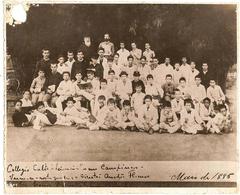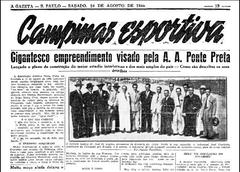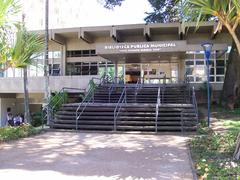Sede Da Fazenda Três Pedras: Visiting Hours, Tickets, and Historical Sites in Campinas, Brazil
Date: 04/07/2025
Introduction
Sede da Fazenda Três Pedras is a captivating symbol of the Campinas region’s rich agricultural heritage and architectural legacy. Established during the coffee boom of the late 19th century, this historic estate reflects the social, economic, and cultural transformations that shaped São Paulo’s interior. Its well-preserved manor house and outbuildings offer an immersive window into rural aristocratic life, the transition from slavery to immigrant labor, and the ongoing evolution of Brazil’s countryside. Today, the fazenda is a cornerstone of Campinas’ Rota Turística de Sousas e Joaquim Egídio, a regional initiative promoting sustainable cultural tourism and community engagement.
This comprehensive guide explores the estate’s origins, architecture, social significance, visiting hours, ticketing, accessibility, and nearby attractions. Whether you are a history buff, cultural traveler, or simply curious about Brazil’s past, Sede da Fazenda Três Pedras offers a unique and enriching experience.
For up-to-date information, consult official resources such as ipatrimonio.org, Campinas.com.br, and Wild Trips.
Table of Contents
- Heritage and Historical Context
- Architectural Features and Restoration
- Social and Economic Legacy
- Role in the Rota Turística de Sousas e Joaquim Egídio
- Visitor Information
- FAQs
- Recommendations and Visitor Tips
- Conclusion
- References
Heritage and Historical Context
The roots of Sede da Fazenda Três Pedras stretch back to the late 1800s, when Campinas thrived as a center of coffee production. The estate originated from the subdivision of large agricultural holdings belonging to prominent families, notably the Camargo Penteado lineage (ipatrimonio.org). The fazenda’s name, “Três Pedras” (Three Stones), references natural rock formations that served as landmarks for early settlers.
As part of the broader coffee economy, the estate exemplifies the rural aristocracy’s influence on regional development, infrastructure, and social life. The abolition of slavery in 1888 and the arrival of immigrant laborers—mainly from Europe and Japan—marked significant turning points in the estate’s social and economic structure.
Architectural Features and Restoration
The manor house, built in 1871, showcases a harmonious blend of neoclassical influences and traditional Brazilian construction methods. Key architectural features include:
- Two-story main house: Brick masonry, rammed earth (taipa de pilão), and stone foundations; wide verandas with distinctive columns; symmetrical facades; and high, ventilated ceilings.
- Auxiliary buildings: Former slave quarters (senzalas), overseer’s residence, barns, and coffee warehouses, constructed using techniques like pau a pique (wattle and daub).
- Estate layout: Walled divisions separated domestic from agricultural areas, including coffee drying yards, orchards, and animal pens.
Preservation efforts have maintained the estate’s authenticity. Notably, restoration projects in the 1960s and 2005 prioritized original materials and design, adapting certain spaces for new uses while retaining historical integrity (isayweinfeld.com).
Social and Economic Legacy
Sede da Fazenda Três Pedras operated at the heart of Campinas’ coffee-driven prosperity, relying on enslaved labor until the late 19th century. The abolition of slavery led to a shift toward immigrant labor, reflecting broader demographic changes across São Paulo (campinas.com.br). The estate’s structures and grounds today tell the story of both the landowning elite and the laborers—enslaved and immigrant—who shaped the region’s identity.
Beyond its economic role, the fazenda was a social hub, hosting cultural events, religious festivals, and community gatherings. This legacy continues through educational programs, workshops, and seasonal festivals that celebrate Campinas’ rural traditions.
Role in the Rota Turística de Sousas e Joaquim Egídio
Officially established in 2024, the Rota Turística de Sousas e Joaquim Egídio connects key cultural, historical, and natural sites in the Campinas region (Campinas.com.br). Sede da Fazenda Três Pedras is a highlight of this route, offering:
- Architectural tours: Exploring colonial and republican-era buildings.
- Cultural programming: Agricultural fairs, workshops, and festivals.
- Integration with local attractions: Proximity to the Campinas Historical Museum, Bosque dos Jequitibás, and other sites adds depth to the visitor experience.
This initiative promotes sustainable, community-based tourism, protecting heritage while supporting local businesses and artisans. Improved signage, digital resources, and guided itineraries enhance accessibility and engagement (Correio RAC).
Visitor Information
Visiting Hours and Tickets
- Open: Tuesday to Sunday, 9:00 AM to 5:00 PM.
- Closed: Mondays and major public holidays.
- Admission: R$15–R$20 for adults; discounted rates for students, seniors, and Campinas residents; children under 12 often enter free.
- Booking: Tickets can be purchased on-site or via the Rota Turística website.
Guided Tours and Events
- Guided tours: Offered daily at scheduled times, including in Portuguese and, upon request, in English. Advance booking is recommended during busy periods.
- Special events: Harvest festivals (July), coffee tastings (September), and cultural workshops are held seasonally. Check official calendars for details.
Accessibility and Facilities
- Wheelchair access: Main areas, including the manor house and gardens, are accessible. Some historic outbuildings and trails may present challenges due to uneven terrain.
- Facilities: Ample parking, restrooms, picnic areas, and a café serving local snacks and beverages. Gift shop features regional products.
- Visitor tips: Wear comfortable shoes, bring water and sun protection, and check weather conditions, especially if exploring outdoor trails.
Getting There and Nearby Attractions
- Location: About 10–15 km from central Campinas; accessible by car, taxi, or shuttle services along the Rota Turística (Mapcarta).
- Nearby sites: Campinas Historical Museum, Bosque dos Jequitibás, Holambra (Dutch heritage and flower fields), Jaguariúna (rural train rides), and other historic fazendas.
FAQs
Q: What are the visiting hours for Sede da Fazenda Três Pedras?
A: Tuesday to Sunday, 9:00 AM–5:00 PM. Closed Mondays and major public holidays.
Q: How much does admission cost?
A: Tickets cost between R$15–R$20 for adults, with discounts for students, seniors, and children.
Q: Are guided tours available in English?
A: Yes, upon request and subject to availability. Booking ahead is recommended.
Q: Is the estate wheelchair accessible?
A: Main areas are accessible, though some historic spaces may have uneven ground.
Q: Can I bring my own food?
A: Yes, picnic areas are available for visitors.
Q: Are pets allowed?
A: Pets are allowed in designated outdoor areas but not inside historic buildings.
Q: Is photography permitted?
A: Personal photography is encouraged; commercial shoots require prior permission.
Recommendations and Visitor Tips
- Book tours in advance during weekends and festivals.
- Dress for comfort: sturdy shoes and weather-appropriate clothing are essential.
- Engage with guides for historical context and stories.
- Support local artisans by purchasing crafts at the gift shop.
- Plan your route to combine your visit with other Campinas attractions.
For current schedules and updates, consult the fazenda’s official website or local tourism platforms (Wild Trips).
Conclusion
Sede da Fazenda Três Pedras is a living testament to Campinas’ rural legacy, architectural splendor, and social complexity. By visiting, travelers connect with Brazil’s coffee-era history and contribute to the ongoing preservation of the region’s cultural identity. Integrated into the Rota Turística de Sousas e Joaquim Egídio, the estate promises an enriching, educational, and memorable experience for all. Plan your visit with the help of the Audiala app, and immerse yourself in the stories, landscapes, and traditions that define this remarkable site.
Download the Audiala app for guided tours, interactive maps, and up-to-date visitor information. Follow us on social media for news and exclusive content about Campinas’ historical sites.
References
- ipatrimonio.org
- Campinas Turismo
- Wild Trips
- Campinas.com.br
- Correio RAC
- Mapcarta
- Isay Weinfeld Restoration
Images and videos of Sede Da Fazenda Três Pedras and the Rota Turística are available on the official tourism website with alt tags optimized for keywords such as “Sede Da Fazenda Três Pedras visiting hours” and “Campinas historical sites.”





